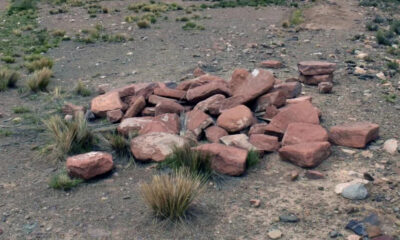Science
Archaeologists Uncover Ancient Tiwanaku Temple in Bolivia

Archaeologists have announced the discovery of what they believe to be the remains of an ancient temple belonging to the enigmatic Tiwanaku civilization, which thrived in the Andean region before disappearing around AD 1000. The impressive temple complex was uncovered in the highlands of Bolivia’s Caracollo municipality, located southeast of Lake Titicaca and approximately 130 miles (about 210 kilometers) south of the well-known archaeological site of Tiwanaku.
The findings were detailed in a study published on June 24, 2023, in the journal Antiquity. The site, named Palaspata after the local term for the area, lies outside the previously established boundaries of the Tiwanaku Empire, marking a significant expansion of knowledge about this ancient society. Dr. José Capriles, a Bolivian archaeologist and associate professor of anthropology at Pennsylvania State University, led the research team and noted the architectural features of the temple—such as a terraced platform and a sunken courtyard—bear resemblance to the Tiwanaku style found elsewhere in the region.
“This discovery is remarkable given its unexpected location,” Dr. Capriles stated. The temple is situated near a historical Bolivian travel route, now known as the La Paz–Cochabamba Highway, which once facilitated trade among various societies, including the Incas.
Insights into the Tiwanaku Civilization
The Tiwanaku civilization has long intrigued researchers, with archaeological investigations dating back to the 1860s. Despite this, much about their society remains elusive. Scholars primarily understand Tiwanaku through the examination of ceramics, animal remains, and religious sites, including the notable Akapana. The Tiwanaku people emerged in the Titicaca Basin, an altiplano that presented challenges for agriculture. To sustain their communities, they relied on llama caravans for trade.
Dr. Nicola O’Connor Sharratt, an associate professor of anthropology at Georgia State University, emphasized that Tiwanaku was a complex society characterized by intricate social hierarchies. “Tiwanaku was what we call a primary state formation, meaning that it developed independently without external influences,” she explained. Evidence suggests that the civilization began to settle in the region around AD 700, with connections extending into modern-day southern Peru, northern Chile, and Cochabamba.
The recent study indicates that the construction of Palaspata was a strategic move to enhance Tiwanaku’s influence over surrounding societies by controlling trade routes. Dr. Capriles noted its strategic placement between significant geographic zones of the Andean Highlands, which allowed it to serve not only as a commercial hub but also as a religious center. “The alignment of religious, political, and economic institutions was surprising,” he said.
The Discovery of Palaspata
The temple, primarily identifiable by its perimeter wall constructed from red sandstone, was first spotted during unrelated archaeological work near the highway. Recognizing its potential significance, researchers undertook further exploration on foot and with drones. Utilizing 3D rendering technology, Dr. Capriles created a digital reconstruction of the site, revealing a structure measuring approximately 125 meters long and 145 meters wide (410 by 475 feet)—similar in size to a city block.
The temple features 15 modular enclosures that likely served as rooms surrounding an inner courtyard. Its main entrance faces west, aligning with the solar equinox, which underscores its religious significance within the society. While specifics about Tiwanaku’s spiritual practices remain largely unknown, previous archaeological work has unearthed stone monoliths and ceramics rich in plant and animal symbolism, hinting at connections to other pre-Inca traditions.
Additionally, artifacts such as keru cups, usually employed for consuming maize-based alcoholic beverages, suggest that Palaspata was a venue for communal gatherings and celebrations. Despite its historical importance, the Tiwanaku civilization continues to pose challenges for researchers seeking to understand its complexities.
The prevailing theories regarding the decline of the Tiwanaku civilization cite environmental factors, such as drought or degradation, potentially leading to social unrest and upheaval. Dr. Sharratt pointed out that early archaeologists struggled to categorize Tiwanaku within their preconceived notions of what constituted a thriving city, contributing to the knowledge gaps surrounding this intriguing society.
The discovery of Palaspata not only sheds light on the architectural and cultural achievements of the Tiwanaku but also opens new avenues for research into the intricate dynamics of ancient Andean societies. As excavations continue, the potential for uncovering further secrets of this lost civilization remains promising.
-

 Technology5 months ago
Technology5 months agoDiscover the Top 10 Calorie Counting Apps of 2025
-

 Health3 months ago
Health3 months agoBella Hadid Shares Health Update After Treatment for Lyme Disease
-

 Health3 months ago
Health3 months agoErin Bates Shares Recovery Update Following Sepsis Complications
-

 Technology4 months ago
Technology4 months agoDiscover How to Reverse Image Search Using ChatGPT Effortlessly
-

 Technology1 month ago
Technology1 month agoDiscover 2025’s Top GPUs for Exceptional 4K Gaming Performance
-

 Technology3 months ago
Technology3 months agoElectric Moto Influencer Surronster Arrested in Tijuana
-

 Technology5 months ago
Technology5 months agoMeta Initiates $60B AI Data Center Expansion, Starting in Ohio
-

 Technology5 months ago
Technology5 months agoRecovering a Suspended TikTok Account: A Step-by-Step Guide
-

 Health5 months ago
Health5 months agoTested: Rab Firewall Mountain Jacket Survives Harsh Conditions
-

 Lifestyle5 months ago
Lifestyle5 months agoBelton Family Reunites After Daughter Survives Hill Country Floods
-

 Health3 months ago
Health3 months agoAnalysts Project Stronger Growth for Apple’s iPhone 17 Lineup
-

 Technology4 months ago
Technology4 months agoHarmonic Launches AI Chatbot App to Transform Mathematical Reasoning













